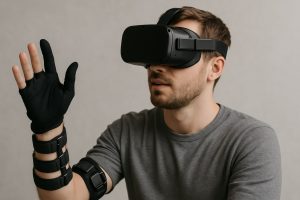- CycleARcade aims to enhance road safety by enabling seamless communication between cyclists and autonomous vehicles using augmented reality headsets.
- The system provides cyclists with virtual interfaces that alert them to potential hazards and convey the intentions of surrounding vehicles.
- Glasgow University researchers, led by Professor Stephen Brewster, developed tools like RoadAlert to improve cyclists’ situational awareness without causing distraction.
- International studies revealed the need for region-specific adaptations in AV communication, emphasizing cultural differences in road navigation.
- CycleARcade represents a new paradigm in human-machine interaction on shared roads, blending technological innovation with insights into human behavior.
- The project will be presented at the CHI Conference, highlighting its potential to transform the dynamics of multi-user transportation spaces.
In the bustling heart of cutting-edge innovation, a unique creation spearheaded by Glasgow University is redefining road safety in an age where the familiar hum of an engine will soon compete with the silent glide of autonomous vehicles. This breakthrough, known as CycleARcade, conjures visions of a not-so-distant future where cyclists and self-driving cars communicate seamlessly, preventing collisions and misunderstandings through an almost prescient dialogue.
CycleARcade deploys augmented reality headsets to catapult cyclists into a world where they interact with the unseen — simulated autonomous vehicles in their very real environment. Imagine cruising down your daily route, but this time, virtual interfaces pop up within your field of vision, alerting you to potential hazards and informing you of the vehicles’ intentions. This high-tech simulator is not just about feeding data; it’s about crafting a new language of motion, urgency, and intent that both cyclists and autonomous vehicles will speak fluently.
Led by Professor Stephen Brewster and a team of bright researchers, the university’s School of Computing Science delves into the psyche of roadway communication. The sophisticated signals that human drivers and cyclists use — a wave here, a nod there — form a silent discourse understood globally. However, with artificial chauffeurs on the rise, cyclists need new eyes in their helmet’s HUD to maintain trust and safety on shared roads.
The research group experimented with various interfaces, sculpting digital tools named RoadAlert, Rearview, and Gem, all designed to heighten cyclists’ awareness of the vehicular ballet around them. These interfaces prioritize critical alerts, focusing on nearby threats — cars looming from behind or those likely to insist on the right of way — while allowing cyclists to remain vigilant about their forward path. Among these innovations, RoadAlert emerged as a favored companion, striking a balance between alertness and distraction.
Meanwhile, another layer of exploration involved the international aspect of cycling culture. Researchers from Glasgow, along with their Swedish allies at KTH Royal Institute of Technology, examined how cyclists from Sweden, Oman, and Scotland navigate roads interwoven with AV traffic. Significant variances in infrastructure and cycling history highlighted that localized adaptations are paramount. Autonomous vehicles, it seems, must become cultural chameleons, adapting communication styles to align with regional norms.
The implications of CycleARcade extend beyond cycling; they represent a fundamental shift in how humans and machines will interact in shared spaces. As researchers prepare to showcase their work at the prestigious CHI Conference in Yokohama, the ripples of this innovation promise calmer and safer waters on the roads of tomorrow. The key takeaway? Building bridges in our asphalt jungles will require not just technological ingenuity but also a profound understanding of human behavior. Are we ready to trust the silent sentinels of the road? With CycleARcade, we might just be.
How CycleARcade Is Revolutionizing Road Safety: The Future of Cyclist and Autonomous Vehicle Interaction
Overview
CycleARcade represents a groundbreaking approach to road safety, especially in an era where autonomous vehicles (AVs) are becoming more common. By integrating augmented reality (AR) with cycling, this technology aims to create a seamless interaction between cyclists and AVs, minimizing accidents and misunderstandings. Developed at Glasgow University under the leadership of Professor Stephen Brewster, this innovation blends cutting-edge technology with psychological insights to transform how cyclists navigate increasingly busy and automated urban environments.
Key Features and Specs
1. Augmented Reality Headsets: Cyclists wear AR headsets that overlay crucial information about their surroundings, helping them to “see” virtual interfaces that highlight potential hazards and vehicle intentions.
2. Interfaces like RoadAlert, Rearview, and Gem: These digital interfaces provide real-time alerts and situational awareness, focusing on threats from different angles and ensuring that cyclists remain informed without unnecessary distraction.
3. Localized Adaptations: Recognizing that cycling culture and infrastructure vary across regions, CycleARcade works to ensure that AV-cyclist interactions are culturally and regionally appropriate.
How CycleARcade Works
1. Simulation Environment: Cyclists enter a simulated world where autonomous vehicles are part of the landscape. This environment enables safe practice and familiarizes them with AV behavior.
2. AR Interface Design: Through interfaces like RoadAlert, cyclists receive priority alerts about nearby cars, especially those with predictable paths that might lead to conflict.
3. Psychological Insight: The technology is designed to mimic the intuitive communication traditionally seen between human drivers and cyclists, such as gestures and nods.
Real-World Use Cases
– Urban Commuters: For cyclists in bustling cities with high AV adoption, CycleARcade enhances safety and confidence.
– Cycle Training Programs: CycleARcade can serve as a training tool for new cyclists learning to navigate AV-dense environments.
– Municipality Safety Initiatives: Cities can incorporate CycleARcade into their urban planning efforts to reduce cycling-related accidents.
Market Forecasts and Industry Trends
The integration of AR and AV technology in transportation is expected to grow significantly. According to a report by MarketsandMarkets, the augmented reality market size is projected to grow from $15.3 billion in 2020 to $77 billion by 2025, at a CAGR of 38.1%. Technologies like CycleARcade are at the forefront of this trend, promising safer and smarter urban mobility.
Controversies and Limitations
– Data Privacy: With CycleARcade collecting data on cyclist and vehicle interactions, privacy concerns are inevitable. Ensuring that data is anonymized and secured is crucial.
– Distraction Potential: While striving to balance alertness with distraction, AR interfaces still risk diverting cyclists’ attention if not designed and calibrated correctly.
Insights and Predictions
Experts predict that as autonomous vehicles become more prevalent, the demand for technologies like CycleARcade will rise. This will lead to safer roads and an enhanced public perception of AVs, contributing to their wider acceptance.
Conclusion and Quick Tips
1. Stay Informed: Cyclists should keep abreast of new technologies like CycleARcade to stay safe in evolving urban landscapes.
2. Advocate for Implementation: Local cycling clubs and safety advocates can push for the adoption of systems like CycleARcade to benefit from its safety features.
3. Engage with Local Governance: Work with city planners to incorporate AR technologies into urban cycling safety plans.
For more information on the future of transportation technology, visit the Glasgow University website for updates and contact details.
This technology underscores the importance of adapting to new realities in urban mobility by using advanced tools to foster safety and coexistence between human cyclists and autonomous vehicles.










More Stories
Genomic Oncology Data Analytics Market 2025: AI-Driven Growth & Precision Medicine Trends Shaping a $4.2B Industry
Wearable Haptics Augmentation Market 2025: Surging Demand Drives 18% CAGR Through 2030
Darknet Data Forensics Market 2025: Rapid Growth Driven by AI-Powered Threat Detection & 18% CAGR Forecast